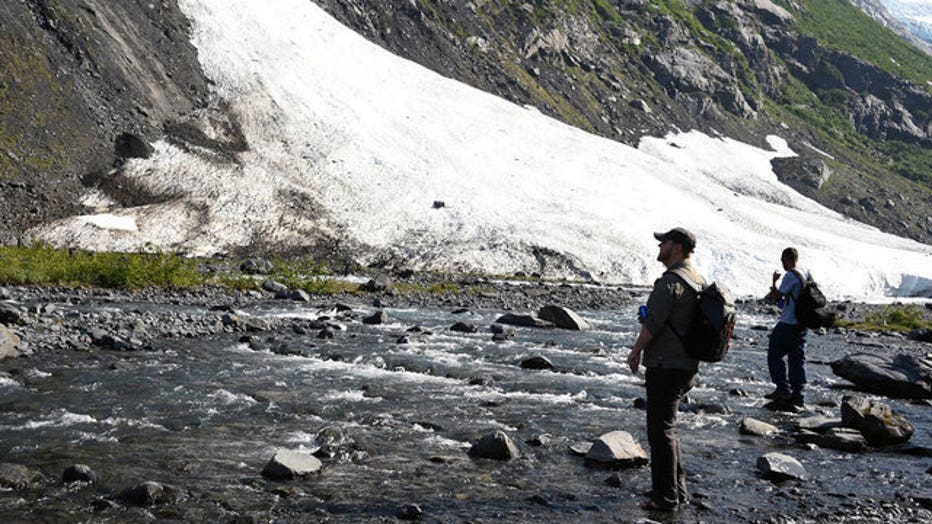Alaskans suffering through 'disaster' drought
ANCHORAGE, Alaska - In one Alaska village, officials are barging in jugs of water and shutting off the public water supply 12 hours each day. In another, automatic flush toilets have been switched to manual flushing, and restaurants are serving meals on paper plates.
Alaska's hot, dry summer has led to extreme measures for severe drought conditions in the Native communities of Nanwalek and Seldovia in the Kenai Peninsula, prompting regional officials to issue a disaster declaration. The arid conditions are more widespread in the vast state -- exacerbated by wildfires still burning. Anchorage, Alaska's largest city, is still fielding smoke drifting from a major wildfire in the Kenai Peninsula this late in the season.
The city is considered to be in extreme drought, according to the National Integrated Drought Information System, while the Kenai Peninsula communities are placed in the lesser severe drought category.
But Anchorage has plenty of water in its system, unlike a handful of small communities that rely on snow melt and rain like Nanwalek and Seldovia to fill their reserves. Their water shortages are acutely felt.
Such scenarios could become more common with climate warming, said Brian Brettschneider, an associate climate researcher at the University of Alaska Fairbanks' International Arctic Research Center. That doesn't mean it will happen every year, he noted.

Two men hike;along a creek below the Byron Glacier on July 4, 2019 near Portage Lake in Girdwood, Alaska. (Photo by Lance King/Getty Images)
"But the probability of this type of summer increases with time as the earth warms," he said.
Even some recent rains didn't quench the thirsty conditions in Nanwalek and Seldovia. "What rain we did have just absorbed into the ground," Gwen Kvasnikoff, the tribal administrator in Nanwalek. "The water rose, and it fell again."
In an average year, the area receives nearly 9 inches of rain from June to August. This summer, it received slightly less than 3 inches.
To conserve the limited supply of water, villagers are using water from the local lagoon for flushing toilets and other nonfood uses, Kvasnikoff said.
Water in 5-gallon jugs is being shipped in to the community of nearly 300. Residents also got some help from the nearby village of Port Graham, which initially had lower-than-normal water levels in its dam until locals plugged some leaks in the system last month. With a larger watershed, that community recently offered water to Nanwalek residents, who took them up on their offer.
Nanwalek's water tank has only 55,000 gallons in it, less than a two-day supply in normal times when the village goes through about 30,000 gallons a day. So local leaders also are shutting off the water system between 9 p.m. and 9 a.m. daily. Because the tanked reserve is standing still at night, residents must boil their water to ward off possible contamination.
"Thankfully, no one is getting sick," Kvasnikoff said.
Seldovia, 10 miles to the northeast, also received a fraction of its normal rainfall. From June to August, the community of about 220 fulltime residents received slightly more than 1 1/2 inches, compared with the average of about 5 1/2 inches.
"The watershed ceased to recharge, and it dried up on us," City Manager Cassidi Cameron said. "It was kind of a perfect storm."
Seldovia has about 16 1/2 days of water left in its reservoir, as of Thursday, she said. To conserve, people are using non-potable water for nonfood uses like laundry. The school has turned off the automatic flushing in toilets and joined restaurants by using disposable plates and utensils. The thrice-weekly senior meals program has been put on hold, and the library is operating under abbreviated hours.
"We're minimizing as much water use as we can as a municipality," Cameron said.
Over the weekend, some rain is forecast for parched south-central areas, including the two villages, but it's not expected to be a super wet storm, according to the National Weather Service.
Next week is expected to return to drier conditions, meteorologist Louise Fode said. Overall, however, the area is expected to begin a wetter pattern, but it won't be as wet as expected this time of year, she said.
"So it's not going to instantly relieve the problems that we're seeing in Seldovia and Nanwalek," she said.

